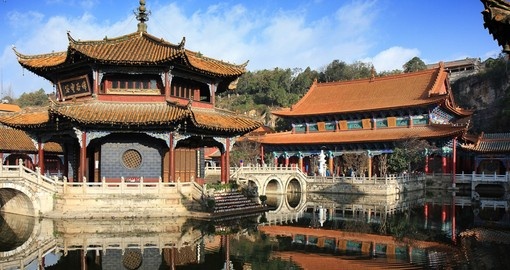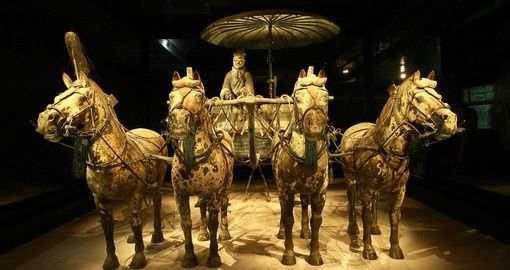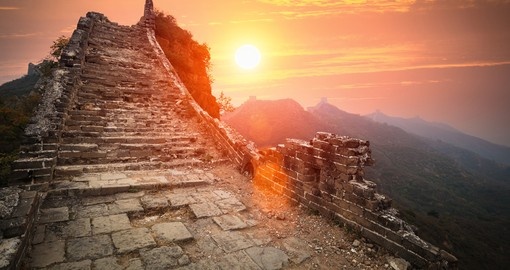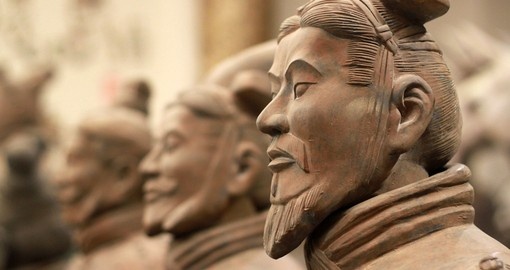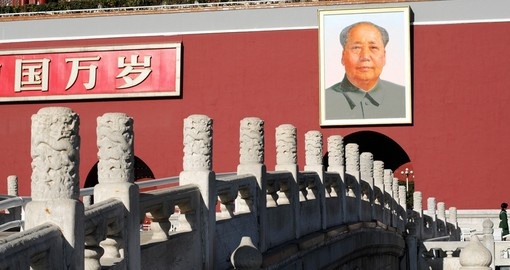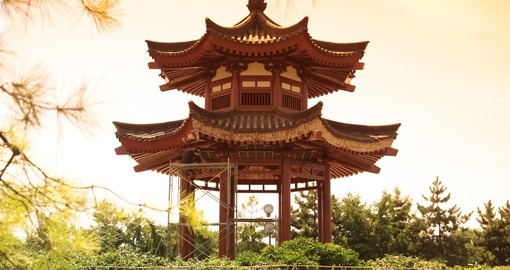China & Tibet History
The history of China has been dominated by conflict, either internally or with outsiders. As a result of this conflict, the shape and size of China have changed many times. Chinese history has also been dominated by dynasties with the Shang Dynasty dating back to 1766 BC.
In the 3rd century BC, the Qin Dynasty became the first to unite all of China. Qin Shi Huang declared himself emperor becoming the first in a long line that lasted until 1912. Qin Shi Huang helped to formalize currency, measurements and written language, all of which helped to further unite the country. The Qin Dynasty was also responsible for building the Great Wall.
With the fall of the Han Dynasty in the 1st century BC came the spread of Buddhism throughout the country. The Tang Dynasty (618-907 AD) witnessed Chàng’an (modern-day Xi’an) become the most impressive capital city in the world. The population of Chàng’an is estimated to have been around one million people. The Northern Song Dynasty (960-1127) was the first to see a truly Chinese economy develop which only grew stronger during the Ming and Qing Dynasties. After Kublai Khan and the Mongols ruled China for a period, control was finally returned to the country with the Ming Dynasty who were responsible for great prosperity and social growth. By the 15th century, European interest in China became serious. Traders were the first to arrive followed by Jesuit missionaries, however, the Portuguese were the ones to really link China with the New World.
The Qing Dynasty was established in the 17th century and much of China’s present territory is a direct result of the Qing Dynasty. During its reign into the 20th century, the dynasty managed to expand borders and encouraged exploration further into central Asia helping to spread Chinese culture and beliefs. By the 18th century, the population of China had doubled to 300 million people. From the middle of the 19th century, the Qing Dynasty was constantly under threat of war resulting in its ultimate demise.
The Republic of China was formed by Sun Yat-Sen in 1911 officially ending the Qing Dynasty. The Chinese Communist Party was founded ten years later. The Japanese invaded in 1937 and were merciless resulting in the deaths of hundreds of thousands of people. China was brought in as Japanese ally during the Second World War, however, they were never really given any significant status. As the Second World War waged on, members of the Chinese Communist Party began staging important guerilla campaigns against the Japanese which helped the cult of Mao, a rising Communist leader, to grow. After the war, a civil war broke out between nationalists and the Chinese Communist Party and after three years, the Communist Party won.
On October 1, 1949 Mao declared the establishment of the People’s Republic of China. Between 1966-1976 China witnessed a Cultural Revolution that involved a massive campaign of ideological renewal. The revolution was very anti-intellectual and was very violent. After Mao’s death in 1976, Deng Xiaoping became the new leader of the People’s Republic of China and his policies were very different from his predecessor. The 1980s were a time of great agitation within China as the population greatly desired political reform. In 1989 an unprecedented demonstration unfolded in Tianamen Square in Beijing. Nearly one million Chinese workers and students filled the square. The Communist Party sent in armoured personnel and while the death toll has never been confirmed, it is believed to be in the high hundreds.
By the 1990s, things began to change in China and economic development became central to the government. Scientific advancement has become increasingly important to the country. China now holds a powerful international role and while the government and the people continue to move forward, there are still many aspects that are very tightly controlled. Despite this, China has remained popular with tourists and is the third most visited country in the world.
Although somewhat controversial, the People’s Republic of China also governs Tibet. It has proven difficult to find archaeological findings in Tibet due to its high altitudes, however, Megalithic monuments dot the Tibetan Plateau and prehistoric Iron Age forts and burial grounds have been uncovered. The written history of Tibet did not begin until the 8th century AD with the introduction of Buddhism to the area. As Buddhism began to grow, so too did the stature and importance of the men who were in charge of monasteries. In the 14th century, an abbott declared that his reincarnated self was to be found and made abbott after him. When this abbott died in 1338, a child born in 1340 was believed to be the abbot’s reincarnation. This tradition became central to the ruling of Tibet and those believed to be the reincarnations were retrospectively given the title of Dalai Lamas.
Tibet developed in relative isolation and by 1850 had closed its doors and borders to foreigners. Under Chairman Mao, the Chinese Communist Party lost little time in asserting Chinese authority over Tibet. In 1951 the Seventeen Point Agreement was created formalising China’s sovereignty over Tibet. Many people were not happy with this arrangement and after an uprising in Lhasa in 1959, the Dalai Lama was forced to flee to India. The government of India accepted Tibetan refugees and land was designated in the mountainous region of Dharamsala where the Dalai Lama and the Tibetan government has remained in exile to today. Under Mao, various temples were destroyed and many people were convicted as political prisoners. In 1965, the Tibet Autonomous Region was created and while a genuine Tibetan was meant to be the head of government, this has never happened. Some foreign governments have criticised the People’s Republic of China’s ruling of Tibet, but most recognise it.
Uprisings occurred in Tibet in 1987, 1989 and 2008. China still refuses to engage in talks with the Dalai Lama who, despite winning the Nobel Peace Prize in 1989 for his dedicated commitment to peaceful protest, remains in exile. Although the political future of Tibet remains uncertain, what is certain is its recent boom in tourism with over two million visitors a year, many of which come from China.
China is responsible for two Special Administrative Regions, Hong Kong and Macau. Historians are unsure when Hong Kong originally came under Chinese rule, however, many agree that control was secured by the time the Han Dynasty came to power. Hong Kong remained part of China until the Opium Wars of the 19th century which saw China cede control bit by bit to Britain beginning in 1842. As a British colony, Hong Kong was a centre for international trade. By 1898 all the territories that make up Hong Kong today were fully under British control.
Hong Kong was eventually returned to China becoming a Special Administrative Region. In this capacity, Hong Kong is governed by a “one country, two systems” style of ruling which allows them a high degree of autonomy and a separate political system. Today, Hong Kong is one of the most exciting cities in the world and is a leading international financial centre. Despite its many business dealings, Hong Kong has become a popular tourist spot not just as a stopover, but also as a vacation destination with over thirty-six million visitors in 2010 alone.
The other Special Administrative Region under Chinese control is Macau. Europeans first began to arrive in Macau in the 16th century. The Portuguese were able to rid the area of troublesome pirates and as a result of this, they were granted land to establish a tiny enclave. As trade with China began to spread, Macau quickly became an important meeting point between China and the West. The Portuguese maintained control over Macau for longer than they did with either Goa or Brazil. However, during the 1970s when Portugal experienced a leftist military coup, the new regime decided that any remaining colonial territory should be made independent, granting Macau “Special Territory” status in 1976.
In 1985 discussions with China began to transfer sovereignty to the People’s Republic. A settlement was ratified in January 1988 and the handover happened in 1999. Today, like Hong Kong, Macau is a popular tourist destination. This is in part due to the Vegas-style casinos that help to fuel the economy as casinos are illegal everywhere else in China. There is much more to experience in Macau that just casinos. Thanks to its many historical attractions, UNESCO recognised it as the “Historic Centre of Macau”, adding it to the World Heritage List in 2005.
China and Tibet Travel Information
At Goway we believe that a well-informed traveller is a safer traveller. With this in mind, we have compiled an easy to navigate travel information section dedicated to China.
Learn about the history and culture of China, the must-try food and drink, and what to pack in your suitcase. Read about China's nature and wildlife, weather and geography, along with 'Country Quickfacts' compiled by our travel experts. Our globetrotting tips, as well as our visa and health information will help ensure you're properly prepared for a safe and enjoyable trip. The only way you could possibly learn more is by embarking on your journey and discovering China for yourself. Start exploring… book one of our China tours today!
Extend Your Trip
After your China tour consider taking the time to visit other destinations. Goway offers exciting India tours and Thailand vacation packages plus a comprehensive selection of vacation packages in many other Asian countries.
Book your China tour with Goway!
 ASIA by Goway is an exclusive division that specializes in planning and organizing China tours, vacations and experiences. Choose from a simple city stopover, see the country highlights on one of our classic itineraries, enjoy a small group tour, a holiday of a lifetime, a stay of distinction and much more. We want to be your first choice when next you go globetrotting to China.
ASIA by Goway is an exclusive division that specializes in planning and organizing China tours, vacations and experiences. Choose from a simple city stopover, see the country highlights on one of our classic itineraries, enjoy a small group tour, a holiday of a lifetime, a stay of distinction and much more. We want to be your first choice when next you go globetrotting to China.
Get a Trip Quote Order a Brochure







